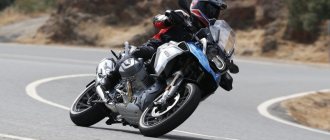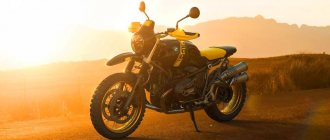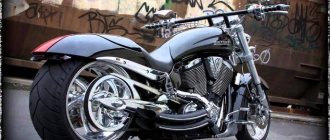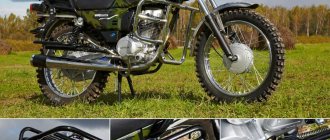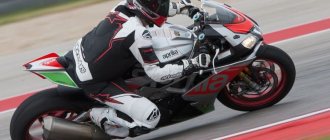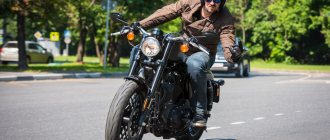Here it is, it’s happened - you are the owner of a motorcycle. Your dream has practically come true (after all, it’s not enough to just buy it). All that remains is not to be disappointed and close the season intact, unharmed, uncracked! Even experienced ones make mistakes or, in the farce of experience, forget that the danger has not gone away. What mistakes do beginners, and not only them, make?
- Choose the wrong motorcycle and equipment
- Drive faster than you can react to the situation
- Don't imagine the entire traffic situation
- Thinking that everyone sees/hears you and remembers you as a motorcyclist
- Ignore weather and daylight hours
Choose the wrong motorcycle and equipment
Much has been said about this in the articles:
“Unsuccessful motorcycles for a beginner - what are they?”
“The ideal motorcycle for a beginner - what is it?”
“The ideal motorcycle for the city - what is it?”
“How not to choose equipment?”
Therefore, let’s just summarize that no matter how strong the desire to jump right into the quarry, common sense must be present when buying a motorcycle and equipment. It is better to start gradually so as not to be disappointed yourself and not to injure someone else.
It will be cold. Choosing the right equipment
When getting on a motorcycle, many people forget that the two-wheeled monster does not have climate control. Without calculating your equipment, you can either get cooked from the heat or turn into a frozen block. Not many beginners are able to correctly assess the weather.
So. If it's hot outside, a mesh shirt worn under a light motorcycle jacket will come in handy. Jackets are usually made of natural material and are able to simultaneously retain heat and allow air to pass through, keeping the body cool on a summer day. Men's polo shirts are the best option for summer, preferred by motorcyclists in most countries.
For cold, windy weather, you should get warm gloves with additional liners and replace your demi-season windbreaker with a warm jacket, even if the temperature is plus ten degrees. Once frozen feet will help you remember to wear warm pants. A good choice would be to purchase Fieldsheer motorcycle pants - these clothes optimally retain heat when riding on frosty days.
Drive faster than you can react to the situation
Experience is partly muscle memory, when you don’t force yourself to work the clutch every time, but already do everything you need automatically, when you don’t look at your feet “where is the gear shift paw?” The motor skills of the arms, legs, and body position will not just appear out of thin air after viewing a couple of blogs of famous motorcyclists. The work has serious weight. How many stories are there about pilots who were racing at maximum speed and simply did not have time to react? The answer is simple: too much.
When you're a beginner motorcyclist, there's no need to chase the Phantom of the Opera. Let someone say that you can go faster or maneuver more boldly. It is possible, of course, but only if experience allows it. Beginner motorcyclists are in a hurry to rise to the level of experienced masters, or at least quickly go beyond the “first-season” line, but they do not always objectively assess their skills.
“What else creates danger on the road for a motorcyclist in the spring?”
"Three tips for surviving a motorcyclist in the city"
“How to pick up a fallen motorcycle and turn it around?”
The best motorcycle models for beginners
In each class of motorcycles there are especially worthy representatives who are recommended as the first iron horse.
Yamaha YBR125
This classic is often chosen by beginners. The total height of the motorcycle is 108 cm, the seat height is 78 cm. Weight is 125 kg. Engine capacity 124 cc. cm, power 10 l. With. The gas tank volume is 13 liters, which allows you to travel up to 460 km. This model is capable of reaching speeds of up to 110 km/h.
The average cost is 160 thousand rubles.
Honda VTR 250
This road bike has a 249cc 4-stroke engine. cm and power 32 l. With. It can accelerate to 150 km/h. The gas tank volume is 13 liters. The height of the motorcycle is 105 cm, the seat height is 78 cm, and the weight is 139 kg.
You can purchase such a unit for 200 thousand rubles.
Suzuki GSF 400 Bandit
This classic has a 4-stroke engine with a capacity of 398 cc. cm and a power of 59 hp. With. The unit can accelerate to 180 km/h. Gas tank volume 16 l. The height of the motorcycle is 106 cm and the weight is 168 kg.
Such a motorcycle costs from 120 thousand rubles.
Kawasaki Ninja ZX-10R
This sportbike has a 4-stroke engine with a capacity of 998 cc. cm and a power of 200 hp. With. The gas tank capacity is 17 liters. The sportbike can reach speeds of up to 299 km/h. Its seat height is 83.5 cm and its weight is 206 kg.
The technical characteristics of this model differ depending on the year of manufacture. A 2016 motorcycle can be purchased for about 130 thousand rubles.
Yamaha YZF1000 Thunderace
This Japanese sportbike has a 4-stroke engine with a capacity of 1002 cc. cm and power up to 145 hp. With. It can reach speeds of up to 264 km/h. The height of this model is 117.5 cm, the seat height is 79 cm, and the weight is 224 kg. The gas tank volume is 20 liters with a reserve of 4.5 liters.
The cost of such an iron horse is from 200 thousand rubles. A used motorcycle can be purchased for about 150 thousand rubles.
Aprilia RS 125
This Italian sportbike has a two-stroke engine with a displacement of 124.8 cc. cm and power up to 24.5 l. With. This model can accelerate to 175 km/h. The height of the motorcycle is 110 cm, the seat height is 80.5 cm, and the weight is 127 kg. Tank capacity 14 l.
The cost of this iron horse is from 250 thousand rubles.
Honda GL1500 Gold Wing
This is one of the most prestigious touring motorcycles. It has a 4-stroke engine with a capacity of 1520 cc. cm and power 100 hp. Gas tank capacity 23 l. The motorcycle can accelerate to 175 km/h. The weight of this model is 360 kg. Seat height 74 cm.
You can buy this motorcycle without mileage for 800 thousand rubles.
Ducati Multistrada 1200 S Touring
This Italian touring motorcycle has a 4-stroke engine with a capacity of 1198 cc. cm and power 150 l. With. Gas tank volume 20 l. The height of the motorcycle is 131 cm, the seat height is 82.5 cm. The unit weighs 196 kg.
The cost of this model is from 1 million rubles.
BMW K1600 GTL
This touring bike has a 4-stroke engine with a capacity of 1649 cc. cm and power up to 160 l. With. The motorcycle is capable of reaching speeds of more than 200 km/h. The gas tank volume is 26.5 liters with a reserve of 4 liters. The height of the unit is 146.5 cm, at the saddle 75 cm. Weight is 321 kg.
The cost of such a motorcycle is from 1.8 million rubles.
Suzuki Boulevard 400
This Japanese cruiser has a 399cc 4-stroke engine. cm and power 33 l. With. It can accelerate to 150 km/h. The saddle height is 70 cm and the weight is 240 kg.
You can buy such a motorcycle for 200 thousand rubles.
Yamaha XV 750 Virago
This cruiser has a 4-stroke engine with a displacement of 748 cc. cm and power 60 l. With. The bike can accelerate to 168 km/h. The gas tank capacity is 14.5 liters with a reserve of 2.5 liters. The height of the unit is 71.5 cm at the saddle, and the weight is 235 kg.
You can purchase such an iron horse for an amount starting from 120 thousand rubles.
Kawasaki VN 2000 Vulcan
This model has a 4-stroke engine with a capacity of 2053 cc. cm and a power of 103 hp. With. The motorcycle can reach speeds of up to 203 km/h. The height of the unit is 115.5 cm, the seat height is 68 cm. Its weight is 371 kg, and the gas tank volume is 21 liters.
The cost will be from 400 thousand rubles.
Don't imagine the entire traffic situation
Firstly, stop looking under the wheel and only straight ahead. Beginners are always scared, but you have to fight it. A motorcyclist is obliged to watch the road even more carefully than a motorist, because you and I do not have a safety cage, a belt will not hold us in the saddle and an airbag will not jump out of the steering wheel.
Secondly, if you don’t have a complete picture of the traffic, then at least you won’t wait for surrounding traffic to change lanes or turn; I’ll say nothing about pedestrians. You may object:
- I can’t know the road maps of the entire city by heart, but what if I find myself in an unfamiliar place?
It is not necessary to know every gateway, it is enough to understand the principle of movement on your site and the approximate plan for the development of events ahead, which can be read from the markings and signs. Beginner motorcyclists sometimes concentrate only on their lane, without even realizing that danger may come from the other side. Or they begin to frantically change lanes when they realize that they are turning from another lane.
And as for other cities... It’s better to look at the map before leaving, at least along the main streets and avenues, so as not to get into a stupid story. And if you know drivers, why not chat with them? Would it really be difficult for your friend to warn you about a dangerous intersection or turn that is easy to miss?
"The feeling of speed while riding a motorcycle"
“What do you need to remember during the opening of the motorcycle season?”
Twenty tips for beginner motorcyclists
1. Always wear protective equipment.
The required minimum is a helmet, gloves, motorcycle boots, knee pads and a motorcycle jacket with built-in protection, or a “turtle.” Don't be lazy to wear a helmet, even if you are going to ride 100 meters. Nobody knows what could happen on the road in a second. 2. Before each ride, inspect the motorcycle: brakes, cables, clutch, light signals, and no damage to the tires. Check the oil level and tire pressure regularly.
3. Constantly improve your driving skills. Knowing how to brake and maneuver in an emergency can save your life. But remember, if you needed to use these skills on the road, you drove yourself into this situation without taking into account any factor, and proper safe driving involves avoiding extreme situations, not fighting them.
4. Obey the speed limit. Falling at speed in most cases leads to injuries that are often incompatible with life.
5. Do not seat a passenger unless you feel absolutely confident. Remember that braking distance will increase, cornering speed will decrease - you will not be able to control the motorcycle as much as when riding alone. Before the trip, give instructions on what the second number should do while driving and what absolutely should not do. Make sure that the second number always has equipment. Slow down and double your attention - now you are responsible not only for yourself, but also for the other person.
6. Keep your distance! Remember, the braking distance of a motorcycle is longer than the braking distance of a car, that is, if the vehicle driving in front of you suddenly brakes, if you don’t keep your distance, you will end up in its trunk. The “half speed” distance is considered safe, that is, if you are driving at a speed of 60 km/h, the distance should be 30 meters, if it is 90 km/h. – 45 meters.
7. Take a dominant position in the lane in which you are moving. It is not recommended to drive directly in the middle of the lane, there may be debris and oil stains, but do not press against the edge, so that drivers of passenger cars do not have the desire to fit in the same lane with you, which may cause you to be “squeezed” to the side of the road or onto the road. oncoming traffic
8. Cross tram tracks and any obstacles at an angle as close as possible to a straight line. Otherwise, a fall is very likely. Also, never brake on tram tracks, the rubber surface around them and on marking lines. Their coefficient of adhesion is much lower than that of the road surface; the wheels can skid, which will lead to a fall.
9. Before going through a turn, slow down in advance and choose a gear in which you will go through the entire turn. Braking while cornering can cause you to lose control of your motorcycle.
10. Your gaze should be directed to where you are going. To put it another way, the motorcycle always goes where your eyes are directed. Practice the habit of “taking turns with your eyes.” If, for example, a dog runs out onto the road and you look at it, a collision with it is inevitable.
11. A very common cause of road accidents is vehicles leaving yards and surrounding areas. When driving on a narrow road, secure all entries/exits and be prepared to apply emergency braking.
12. Pay attention to where the wheels of parked cars and cars standing in a traffic jam are pointing. If the wheels are turned out, there is a possibility that the car will make an unexpected maneuver and end up directly in front of you. The same with cars standing or slowing down near the center line in the oncoming lane. The driver could make a turn or U-turn right in front of you, the consequences could be fatal.
13. When driving in a traffic jam, you are always at risk that the driver or passenger may unexpectedly open the door without thinking about the possibility of a motorcycle being nearby. Never drive it faster than 15-20 km/h. Another danger is that pedestrians often try to cross the road in the wrong place when all the traffic is standing still, and they can suddenly run out right in front of you. Do not press against cars standing on the side of the road - their doors open just as thoughtlessly and unpredictably.
14. When driving in traffic, it is best to drive at its speed, controlling the situation around you, and not allowing cars to approach you at an unsafe distance. It is possible to drive 20% faster than the flow of traffic, but in this case you must remember that you become invisible to most road users and take this into account when choosing your distance, lateral spacing and maneuvers.
15. Learn to be visible and predictable to other road users. Serviceable lighting devices, additional motorcycle lighting, a bright vest and reflective elements are your passive safety.
Thinking that everyone sees/hears you and remembers you as a motorcyclist
Friend, I have bad news for you. If you bought a bike and think that now the whole city will only talk about your “Alpha” and the whole Instagram will be littered with your photos, then this will most likely happen only in two cases:
A) You drive very poorly and park even worse
B) The bumper of your neighbor’s car finally caught up with you
The truth is that there is always a motorist who needs to answer a call, write a message, play “dandy” or you are in his blind spot, so returning to the previous point: you should monitor the situation first of all! It is reckless to assume that you are heard and inferior because of the forward flow or seen simply because you have a beautiful Icon jacket.
“How to drive so that other drivers can see you?”
Which motorcycle class is preferable for a beginner?
Any motorcycle belongs to some target group. Based on this criterion, such vehicles are classified into on-road and off-road. Special mention should also be made of motorcycles with a narrow specialization - this applies to pit bikes for mini-motocross and mini-supermoto, dragsters for drag racing, and minibikes for go-karting. The rest of the equipment can be used by amateurs.
There are the following classes of motorcycles:
- Classic . Motorcycles of this type are great if you plan to move quickly and occasionally get stuck in traffic jams. Such units are also called road units. The design of the classic resembles Soviet technology, but with a powerful engine.
- Sports . Such motorcycles are also called sportbikes. They are easy to recognize when the engine is running by their characteristic sound, reminiscent of a jet plane. Sportbikes provide extreme riding on smooth roads. When designing them, they strive to reduce aerodynamic drag at high speed, so the equipment is equipped with a frontal fairing and an engine fairing.
- Superbike (supersport) . This technique is considered an improved version of sport bikes. They surpass their predecessors in power, lightness, speed and controllability.
- Sports and tourism . This option is great for long rides due to the convenient location of the handlebars and footpegs. The name of the motorcycle was given for the ability to sit in two positions - a flat back means a touring option, and a forward tilt means a sporty one.
- Cruisers . They are distinguished by a low seat, a comfortable upright position, a powerful engine, reinforced suspension and brakes. Cruisers can be used for long trips, but rough terrain and fast driving are not for him.
- Motard . These motorcycles are purchased to ride on the roads. They are distinguished by a high seating position, a powerful engine and good handling.
- Heavy motorcycles . Such vehicles are distinguished by the presence of a side trailer, large weight and low speed. All this, coupled with a powerful engine, allows you to drive off-road and transport large items.
- Choppers . This type is characterized by the maximum forward throw of the front fork, a narrow front wheel with a large circumference. Choppers have wide footrests and a handlebar that is twice as wide as the shoulders.
- Trikes . This type is a classic chopper and an expensive pleasure.
- Cross motorcycles . Their purpose is cross-country motorcycle racing and extreme riding. There are even special children's models. Motocross motorcycles have a two-stroke engine, minimal weight, a durable frame, a powerful engine and a strong suspension with a long stroke. The front wheel is usually larger than the rear, there is no lighting equipment.
- Enduro . With such motorcycles they master off-road tourism. This equipment is distinguished by its low weight, long-travel suspension and maintainability. Unlike motocross motorcycles, enduro motorcycles have lighting technology.
- Supermotard . This representative is created on the basis of cross-country motorcycles, has one cylinder and sports tires, so it should be ridden on hard roads.
For beginners, it is better to choose a classic type motorcycle.
This is the best option for getting your first experience. Its indicators allow you to learn competent control, cornering and confident landing. Beginners can also master a sports touring motorcycle, but on the condition that the engine capacity is up to 400 cc. cm.
Fans are usually limited to choosing a motorcycle among classics, sportbikes, touring units and cruisers.
Practical lessons.
Some people believe that passing the Category A test makes them an experienced racer. Nothing could be more wrong. This is just the beginning of a long and exciting journey to winning this title. Exercises will help you with this. Find a safe place - a supermarket parking lot, a closed road, a driving school maneuver area. Practice dodging, overcoming obstacles and other simple maneuvers. This will allow you to develop appropriate habits and develop muscle memory. The more time you spend behind the wheel of a motorcycle, the better.
To take exams at the traffic police you need to provide the following package of documents:
1. Statement. It is filled out on letterhead directly at the traffic police department where you will take the exam. 2. Driver’s examination card and, if you graduated from a motorcycle school, a certificate of completion of training in the appropriate program. 3. Medical certificate, which we talked about above. 4. Two photographs 3.5x4.5 cm on matte paper with a right angle. If your traffic police issue modern certificates in the form of a plastic card, then photographs are taken at the traffic police before passing the exam. 5. Passport or a document replacing it, confirming your registration. 6. Receipt of payment of the test fee and driver's license. As you can see, you need very few documents. If you successfully pass the first part of the exam - the theoretical one - a corresponding entry is made in your exam card. It is valid for three months and if during this period of time you have not passed the practical part of the exam - driving - you will have to retake it again. If you failed to pass the practical part of the exam, then the next attempt will be given no earlier than seven days later - you will still have time to practice. We’ll talk about the methodology for passing the traffic police exam in the next chapter.
Timoshenko Andrey
Tip five. No need for companies!
AT FIRST it is better to travel alone.
This advice may seem strange, but I find it vitally important. Now that you have completed your training, you are confident enough in the saddle - of course, you want to show yourself and see other bikers, hang out, as they say now, among your own kind. It’s a completely understandable desire, for God’s sake – hang out! Just don’t end your conversation with a trip in a friendly company. You can’t imagine how many people suffered because of this! It always looks about the same. A group of motorcyclists gathers - someone in it rides better than others. And so he breaks away from the traffic light and flies forward. The rest are trying to keep up, but how could it be otherwise! This is where danger lurks. Let's say a standard situation: on a two-lane road, one car overtakes another, and motorcyclists begin to wedge between them. One, two, three... They had enough experience, speed and luck. On the fourth or fifth, the gate slammed shut - the cars were aligned side by side, leaving you no living space.. Situations can be different. The result, unfortunately, is the same: luck does not always make up for the lack of experience. Therefore, it is strictly not recommended for beginners to ride in a group. Yes, even skilled motorcyclists should avoid this. Such trips invariably turn into a race for the leader. And when you are alone, you drive to the best of your strength, your reaction, your vision of the situation - and no one forces you to do otherwise. And one more thing: for the first year or two, don’t ride girls in the back seat! I foresee an indignant reaction from young readers: of course, because very often they buy a motorcycle in order to win the heart of their beloved. And many young ladies dream of being taken for a ride on a powerful motorcycle. But remember once and for all: the slightest emergency situation - and you risk losing your companion. To lose – in the darkest sense of the word. And even when you become a sufficiently experienced motorcyclist to take passengers without great fear, take all precautions. First of all, “pack” the girl like a precious fragile vase, stock up on the best and most reliable equipment for her. And only then invite you for a ride. Author Vyacheslav KITSIS Publication Klakson No. 7 2009
"I have time…"
If during any maneuver such a thought arises in your head, let it go. It doesn’t matter whether it’s about overtaking, crossing the rails in front of an oncoming tram, or entering an intersection on a yellow light. A novice motorcyclist is too optimistic about his abilities and the situation on the road. The belief that I will “get it done” does not take into account unforeseen factors - that the car being overtaken will accelerate; that you are slipping and tipping over on the rails. It's definitely safer to wait to maneuver and make sure you do it safely.
What will help if your motorcycle falls?
By installing plastic fairings, motorcyclists often save their motorcycle frame from damage. It's not common among experienced bikers to admit to stupid mistakes when their bike falls down. But the statistics are stubborn - everyone drops their motorcycles, regardless of experience, and accidents have nothing to do with it.
See also: A real biker's equipment for any weather
If the motorcycle is sports, then repairing pieces of plastic that fly off during a fall, so insignificant at first glance, can have a significant impact on your wallet. Therefore, by installing sliders that will take the brunt of the impact when the motorcycle falls, you can save on repairs and maintain the beautiful appearance of your “iron friend.”
Sliders mounted on the frame will allow beginners to quickly learn the intricacies of riding when learning at low speeds (without fear of killing the paint and frame of the motorcycle) and will protect the base of the motorcycle from damage. The continued use of sliders is also mandatory - some motorcycles have standard holes for mounting protective fasteners.
Use the front brake moderately
A beginner should not overindulge in the front brake when driving at high speed. They can easily overdo it when braking. This rule is skipped when taking a crash course in motorcycle operation. Many people learn this point directly by experience, trying to make a turn by accelerating well and braking with the front wheel. Over time, as you gain experience, you will begin to feel the main front brake much better, but you still need to combine braking with both brakes. Use the rear brake as an additional brake. "supports".
Independent exercise No. 3
Learning to drive a motorcycle The name of the exercise is correct! Don’t drive yet, just lead him “by the horns”, behind the wheel. Having removed the motorcycle from the stand, we make sure that the gearbox lever is in the neutral position and, slightly tilting the motorcycle towards us, slightly push it forward, holding the motorcycle with both hands on the handlebars, and drive it around the yard or area. First, we practice moving in a circle counterclockwise - this is easier to do, since the motorcycle is slightly leaned on top of you. Then we make circles clockwise. When driving a motorcycle, we learn to stop at the intended object using the handbrake handle. Do this exercise until you feel that the motorcycle no longer wants to fall, and its behavior is completely under your control.
Independent exercise No. 4
Sliding downhill Having worked the previous exercise, move on to the next one. For this you will need to find a site with a slight slope. Sitting in the motorcycle seat, push off your feet from the ground and start moving downhill. If at the same time you feel that the motorcycle is starting to lean to the right or left, level it by turning the steering wheel in the appropriate direction. When driving the motorcycle downhill, use the handbrake to prevent the motorcycle from accelerating too much. Practice this exercise until you achieve the ability to confidently maintain your balance. For the next step of the exercise, ride down while standing on the left footrest of the motorcycle, and at the end of the incline, move your right leg over the saddle and sit in it. It is also necessary to learn how to accelerate the motorcycle and jump on it while moving. This may come in handy if the kickstarter is broken or the battery is dead. Having mastered this exercise and feeling that the motorcycle is completely obedient to you, we proceed to start the engine.
Good tires
It’s not enough to buy good tires - it’s important to change them on time. Many motorcyclists exceed the service life of rubber by three to four times. By driving on bald tires and trying to save money in this way, you can lose much more. And while driving on worn tires is simply dangerous for a car, it is deadly for a motorcyclist.
Michelin Pilot Road 4 is considered the best option for off-season tires; these wheels are quite resistant to aggressive driving and experimentation. Dunlop Q3 is considered a sports tire. It is better to put such tires on the front wheel, and the traditional Pilot Road on the rear. This way you can get optimal grip on the road. According to experts, it's better to lose some grip at the rear of the bike but maintain a solid front. If it's the other way around, you might end up with "Big Trouble in Little China."
Technical condition
Young people don't always come with a deep pocket, so many young riders buy a motorcycle at the lowest price possible so they can afford inspection, registration and insurance. Maintenance and possible repairs are often delayed. Jumping into a brand new and 'trouble free' R1 imported from Germany may not be the best decision. An older model of motorcycle will cost less to maintain, and some of the steps can be done yourself. Thanks to this, you will be racing on the roads on an economical motorcycle, instead of looking at the car sitting in the garage waiting for money.
First liter
After passing the driving license category A test, we are looking for the bike of our dreams. The first bike should have power proportional to the skills of the new motorcyclist - 250 is best. Unfortunately, many young motorcyclists, craving the thrill, speed and roar of the engine, immediately get on a big motorcycle, believing that they are capable of mastering it. When buying your first motorcycle, remember the principle of limited trust - in this case, in your own capabilities. In the beginning, instead of focusing on how fast you'll get to 60 mph, focus on less power and speed, less weight on the bike, and whether your feet reach the ground. A liter may be too much to begin with!
Use the entire lane
The topic is very controversial. Should a motorcyclist traveling relatively slowly ride on the edge of the road?
In my opinion no. Politeness is a great feature, but in practice I have been passed by car drivers many times, and a truck tire can not only damage the mirror, but also kill me.
It's better to drive in the middle of the lane. Of course, we are not talking about a situation where you are traveling on an expressway and your scooter is traveling at 45 km/h.
Appearance of a motorcyclist
A helmet is the most important element of a motorcyclist’s clothing. Buy the safest full-face helmet you can afford. The helmet is designed to protect your brain, so don't skimp on it. Buy protective gloves, motorcycle boots, a suit or jacket and trousers - they don't have to be new, but they should perform their protective functions. Motorcycle clothing provides additional protection from minor falls, and the appearance of the motorcyclist can be a pleasant side effect. Does it make sense to ride in a T-shirt, jeans and sneakers? No!
Throttle is very sensitive
You've probably seen a video on YouTube where a novice motorcyclist clings to the unscrewed roller gas and crashes into some kind of fence, tree or something else. Do you think this only happens to newbies? Oh no. A small engine with a small flywheel responds to throttle input much more strongly than a larger engine.
Lack of experience means that as a newbie you will often find yourself refueling too much. In some situations you may even lose control of the motorcycle. The reality is that throttle control takes practice, so don't get too crazy and know that it's a difficult art.
Independent exercise No. 5
Let's start the engine Let's assume that the motorcycle's power and ignition systems are working properly, there is fuel in the tank, and the battery is fully charged. First of all, before starting the engine, make sure that the gear lever is in neutral. Then smoothly press the kickstarter pedal two or three times. In this case, the enriched mixture enters the engine cylinder. Now insert the key into the ignition and turn the key to the “On” position. The indicator lamp should light up. Then turn the throttle 1/3-1/4 turn and sharply press the kickstart pedal. If everything is adjusted correctly, the engine will start immediately. When starting the engine, never turn the throttle all the way, as this will allow too much air to enter the cylinder, the mixture will become lean and it will be difficult to start the engine. After starting the engine, let it warm up to approximately 60 deg. If your motorcycle has a water-cooled engine, this can be easily done using the appropriate tool. If there is no such sensor, then you can resort to the old “old-fashioned” method. Place your palm on the cylinder. If it still endures, but the back side does not, then the engine has warmed up to operating temperature.
line of sight
Speed is perhaps the biggest enemy of motorcyclists. With every additional kilometer, the field of view on the speedometer decreases, and the problem of determining the distance to an obstacle increases. The appearance of danger triggers a series of protective reactions, such as gas release and fixation. To prevent this from happening, drive slower. Let the slogan “10 less” guide you every time you hit the road. Also practice visual inspection. Thanks to this, you will expand your field of vision and learn to see those elements that may pose a threat.
Independent exercise No. 2
Removing the motorcycle from the stand Now we learn how to remove and put the motorcycle on the stand. Stand to the left of the motorcycle. With your left hand, grab the handlebars, and with your right hand, grab the handle on or near the saddle. Push the motorcycle forward until it jumps off the stand and onto its wheels. At the same time, be careful and careful. Having stood on its wheels, the motorcycle will immediately begin to fall on its side. When you push it off the stand, try to let the motorcycle lean slightly towards you - you will probably be able to hold it quite easily. But if the motorcycle starts to fall in the opposite direction from you, then you have practically no chance of holding it! Having held the motorcycle, we learn to put it on a stand. You may need to do this exercise several times until you can quickly and confidently remove, hold, and place it on the stand.
